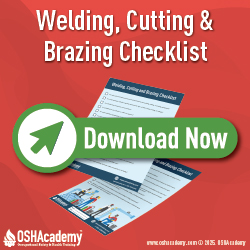Welding, Cutting, and Brazing Self-Inspection Checklist
Below is a sample of a checklist for use prior to welding, cutting, or brazing tasks. (Source: Oregon OSHA)
- Do you allow only authorized and trained personnel to use welding, cutting, or brazing equipment?
- Are compressed gas cylinders regularly examined for signs of defects, deep rusting, or leaks?
- Are cylinders kept away from sources of heat?
- Are employees prohibited from using gas cylinders as rollers or supports?
- Are empty cylinders clearly marked, with valves closed and valve-protection caps in place?
- Are warning signs posted that say “DANGER — NO SMOKING, MATCHES, OR OPEN LIGHTS,” or a similar message?
- Are cylinders, valves, couplings, regulators, hoses, and tools kept free of oil and grease?
- Unless secured on special carts, are regulators removed and valve caps installed before cylinders are moved?
- Do cylinders without fixed hand wheels have proper tools (keys, handles, or nonadjustable wrenches) on their valves when in use?
- Are liquefied gas cylinders stored and shipped upright, with valve covers in place?
- Before a regulator is removed, is the cylinder valve shut off and gas released from the regulator?
- Is the open-circuit (no load) voltage of arc welding and cutting machines kept as low as possible and within recommended limits?
- Are electrodes removed from holders when not in use?
- Are employees required to shut off electric power to welding machines when not in use?
- Is proper fire-extinguishing equipment available and ready to use at all welding and cutting locations?
- Are welders forbidden from coiling or looping welding electrode cables around their bodies?
- Are work and electrode lead cables regularly inspected for damage and replaced when needed?
- Do cable connectors have adequate insulation to prevent electric shock or fire?
- When the item being welded cannot be moved and fire hazards cannot be removed, are fire-resistant shields or blankets used to confine heat, slag, and sparks?
- Are fire watchers assigned when welding or cutting is performed in locations where fires could start?
- When welding on metal walls, are steps taken to protect flammable materials on the opposite side?
- Before hot work begins, are drums, barrels, tanks, and containers properly cleaned and tested to make sure no flammable or toxic materials are left inside?
- Do eye-protection devices—like helmets, shields, and goggles—meet the correct safety standards?
- Do workers wear the right personal protective equipment (PPE) for welding, cutting, or brazing hazards?
- Do you check that the area where welding or cutting is done has proper ventilation?
- When welding in confined spaces, is the atmosphere monitored, and is there a rescue plan in case of emergency?
- Are regulator pressure-adjusting screws released when hot work is stopped for a long period of time?

